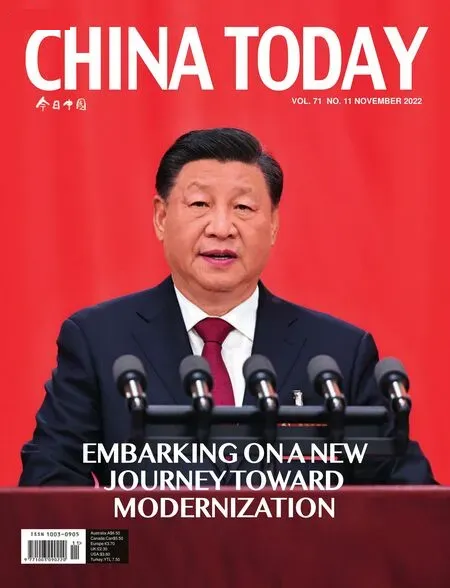Cultural Treasures from the Tang Dynasty

A tri-color glazed terracotta female figure, a funerary object from the Tang Dynasty, was unearthed from the tomb of Xianyu Tinghui in Xi’an, Shaanxi Province in 1957.
Li Yuan, a military governor during the declining years of the Sui Dynasty, captured the imperial capital Chang’an and established the Tang Dynasty in 618. After his son Emperor Taizong (598-649) ascended to the throne, he implemented a series of measures to consolidate the unity of the country, resulting in the economic recovery of the country as well as the increased military strength.
Li Yuan, a military governor during the declining years of the Sui Dynasty, captured the imperial capital Chang’an and established the Tang Dynasty in 618. After his son Em peror Taizong (598-649) ascended to the throne, he implemented a series of measures to consolidate the unity of the country, resulting in the economic recovery of the country as well as the increased military strength.
AT the early stage of the Tang Dynasty, during the reign of Emperor Taizong, Empress Wu Zetian, and Emperor Xuanzong, it maintained a national unity throughout the territory of its vast empire and consolidated political power. It boasted a prosperous economy and splendid culture. Different ethnic groups enjoyed close interaction. The country also strengthened economic and cultural exchanges with its neighbors, with its capital Chang’an becoming a center of economic and cultural exchanges.
At the height of its prosperity, the borders of the Tang Dynasty territory extended to the East Sea in the east, the Aral Sea in the west, Lake Baikal in the north, and the South China Sea in the south. It became a big multiethnic empire with a vast territory, abundant natural resources, and a large population. The ethnic minorities which established local governments during the Tang Dynasty included the Tujue, Uygur, Tubo, Nanzhao and Bohai.
During their development, the various ethnic groups learned from the advanced economy and culture of the Tang Dynasty, and in return influenced the Han nationality with their own economic and cultural creations. The joint efforts of the Han and other ethnic groups promoted the prosperity of the Tang Dynasty as a whole. The frequent exchanges both between all nationalities at home and with other countries injected vitality into the economy of the Tang Dynasty. The long-term unification of the country and the relative stability of the society ushered in an unprecedented economic prosperity of the Tang Dynasty during this period.
The development of agriculture in the Tang Dynasty provided a material basis for the progress of the handicraft industry. The government-run handicraft operations occupied a dominant position, and its large scale, fine division of labor, sufficient raw materials, and abundant labor force enabled the production of many exquisite goods. Private handicraft workshop also flourished. The combination of agriculture and cottage industry was still the hallmark of the traditional economy in the Tang Dynasty. The progress of agriculture and the female handicraft industry in the Tang Dynasty promoted the development of the commodity economy, and many famous cities emerged successively.
The Tang Dynasty was one of the most civilized and affluent countries in the world at that time, making it a strong attraction to other countries. The Tang Dynasty maintained friendly relations with many countries in the world, especially its neighboring ones. Envoys, trade caravans, and travelers kept coming in and out of the country, and the economic and cultural exchanges between China and foreign countries developed unprecedentedly. The rich culture, especially advanced techniques such as papermaking and textile technology, was spread to Asian and European countries, while at the same time, Western culture, art, and religion were also introduced to China. The Tang Dynasty widely absorbed the culture of other countries with an open mind and was greatly enriched thereby.
The culture of the Tang Dynasty was profound and far reaching in its influence on later generations. In the field of science and technology, breakthroughs and innovations were made in astronomy, geography, medicine, and block printing. There were also outstanding achievements in the areas of literature and art, especially in poetry, calligraphy, painting, sculpture, music, and dance. With the prosperity of the cities, the social life of the people underwent great changes, reflecting a thriving, free, and open spirit.
(Selected fromA Journey into China’s Antiquity: Chinese History in Cultural RelicsCompiled by National Museum of China Published by Blossom Press)

A Silver bowl inlayed with two golden fish, a food container, was unearthed in Hejiacun Village, Xi’an of Shaanxi Province in 1970.


A white porcelain bottle with a long neck, a container for holding drinks, was unearthed from Shanxian County in Henan Province in 1957.

A gilded bronze mirror inlaid with green and white glass beads, a portable mirror for women to use when going out, was unearthed in Xi’an of Shaanxi Province.

Fan-shaped silver hair sticks from Tang Dynasty.

